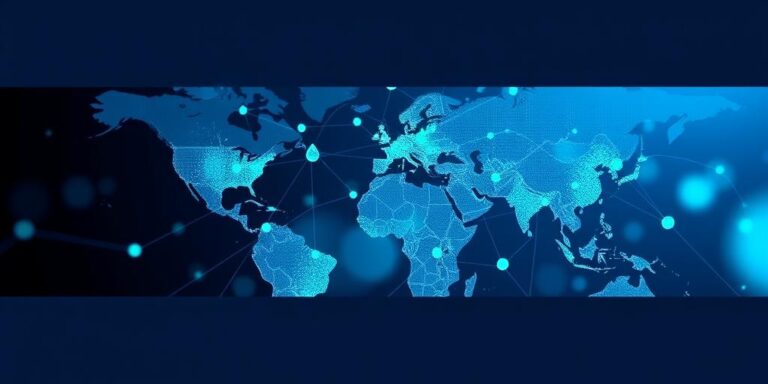Water Management with IoT: Conservation and Leak Detection (2026)
Water scarcity is becoming an increasingly pressing global issue, demanding innovative solutions for efficient water management. The Internet of Things (IoT) offers a promising avenue to address these challenges through advanced monitoring, control, and automation. By 2026, IoT-based water management systems are expected to be widely implemented, transforming how we conserve and detect water leaks.
The Promise of IoT in Water Management
IoT technology involves deploying interconnected sensors, devices, and networks to collect and analyze data. In the context of water management, this technology enables real-time monitoring of water usage, quality, and infrastructure conditions. Here’s a detailed look at how IoT contributes to water conservation and leak detection:
- Real-Time Monitoring: IoT sensors can be installed in pipelines, reservoirs, and distribution networks to provide continuous data on water flow, pressure, and quality. This real-time visibility enables prompt identification and resolution of anomalies.
- Smart Metering: Traditional water meters are being replaced by smart meters that provide detailed consumption data. These meters communicate with a central system, allowing users and utilities to track water usage patterns and identify potential inefficiencies.
- Leak Detection: One of the most significant benefits of IoT in water management is the ability to detect leaks early. Sensors can identify unusual drops in pressure or increases in flow rates, indicating a leak. Automated alerts can then be sent to maintenance teams for immediate action.
- Automated Control: IoT systems can automate water distribution based on real-time demand. Smart valves and pumps can adjust flow rates to optimize water delivery and reduce waste. This is particularly useful in agricultural settings, where irrigation can be precisely controlled to match crop needs.
Key Applications and Benefits
IoT in water management has a wide array of applications, each offering unique benefits. Here are some notable examples:
- Smart Agriculture: IoT-enabled irrigation systems use soil moisture sensors and weather data to optimize water usage. This reduces water waste, improves crop yields, and lowers operational costs.
- Urban Water Management: Cities can use IoT to monitor water distribution networks, detect leaks, and manage water pressure. This helps ensure a reliable water supply, reduces water loss, and improves overall system efficiency.
- Industrial Water Usage: Industries that consume large volumes of water can use IoT to monitor and optimize their water usage. This leads to significant cost savings, reduced environmental impact, and improved sustainability.
- Residential Water Management: Smart home systems can integrate with smart water meters to provide homeowners with real-time water usage data. This encourages water conservation and helps detect leaks early, preventing costly damage.
Challenges and Considerations
While the potential of IoT in water management is immense, there are challenges to consider:
- Data Security and Privacy: IoT devices collect vast amounts of data, raising concerns about data security and privacy. Robust security measures are needed to protect sensitive information from cyber threats.
- Interoperability: Ensuring that different IoT devices and systems can communicate with each other is crucial. Standardized protocols and open platforms are needed to facilitate interoperability.
- Cost and Scalability: Implementing IoT solutions can be costly, particularly for large-scale deployments. Cost-effective solutions and scalable architectures are needed to make IoT accessible to a wider range of users.
- Infrastructure: Reliable connectivity is essential for IoT devices to function effectively. Investment in robust communication infrastructure is needed, particularly in remote areas.
The Future of Water Management with IoT
Looking ahead to 2026 and beyond, the integration of IoT in water management is poised to expand significantly. Advancements in sensor technology, data analytics, and artificial intelligence will further enhance the capabilities of IoT systems. Here are some trends to watch:
- AI-Powered Analytics: AI algorithms will analyze data from IoT sensors to identify patterns, predict water demand, and optimize system performance. This will enable more proactive and efficient water management.
- Digital Twins: Digital twins, or virtual replicas of physical water systems, will be used to simulate different scenarios and optimize system design and operation. This will help utilities make more informed decisions and improve system resilience.
- Edge Computing: Processing data at the edge, or closer to the source, will reduce latency and improve the responsiveness of IoT systems. This is particularly important for real-time leak detection and automated control.
- Blockchain Technology: Blockchain can be used to ensure the integrity and transparency of water data. This can help build trust in water management systems and facilitate collaboration between different stakeholders.
Conclusion
The integration of IoT in water management represents a transformative approach to addressing water scarcity and improving the efficiency of water systems. By providing real-time monitoring, leak detection, and automated control, IoT empowers utilities, industries, and individuals to conserve water and reduce waste. As technology continues to evolve, the potential of IoT to revolutionize water management will only continue to grow, paving the way for a more sustainable and resilient future.




